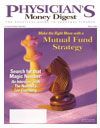Publication
Article
Don't Miss Out on a Tax Break Opportunity
Author(s):
Although Roth IRAs are wellknown in the financial planningworld, they have yet toreceive attention among the medicalcommunity. One reason for this lackof awareness is income limits. Once anindividual earns more than $110,000or joint filers make more than$160,000, they no longer qualify tocontribute to a Roth IRA. Since establishedphysicians usually earn morethan this annually, traditional IRAsare usually recommended. But, mostresident starting salaries fall under thislimit, even with the additional incomeof a spouse. During residency, contributingto a Roth IRA is a simpleway to save on taxes.
Although the Roth IRA looks likeother individual retirement accounts, ithas some basic differences. The age atwhich retirees must begin to take requiredminimum distributions (RMDs)for traditional IRAs is 701/2. For theRoth IRA, withdrawals are tax-free ifyou have reached age 591/2 or are disabledand the account has been held for5 years. Withdrawing money from yourRoth prior to this age results in a 10%early distribution penalty.
Contributions to a Roth consist ofafter-tax dollars, and investors benefitfrom tax-free growth and withdrawals.With a traditional IRA, your pretax contributionsare considered taxable incomewhen taking RMDs, and therefore aresubject to income tax, with the idea thatyou will be in a lower tax bracket.
Starting a Roth IRA is easy. Simply goto a financial services company and askto open one. They are happy to help andare willing to answer questions from themundane to the technical. The followingproviders offer the Roth IRA:
•T. Rowe Price; 800-225-5132;www.troweprice.com
•Fidelity; 800-343-3548;www.fidelity.com
•T.D. Waterhouse; 800-934-4448;www.tdwaterhouse.com
•Scottrade; 800-619-7283;www.scottrade.com
Almost all providers offer age-basedmutual funds that automatically distributeyour contributions into the appropriateinvestments based on your age andprojected year of retirement. Such convenientinvesting guarantees appropriatediversification of your money withouthaving to actively make changes.
An automatic withdrawal plan thattakes money out of your paycheck orbank account directly can help youstart saving. Based on the currentmaximum contribution of $4000, youcan contribute $333 a month. Even$50 to $100 a month will add up overthe course of 30 years.
, is a resident in pediatrics
at the University of Illinois in Chicago and
has given financial planning talks to multiple
resident groups. He welcomes questions or
comments at 312-643-1232 or mksheth@gmail.com. This article was developed in consultation with
Bhasker Baman, CFP®, CEP®. He welcomes questions or
comments at bbaman@comcast.net.
Mehul Sheth, DO
